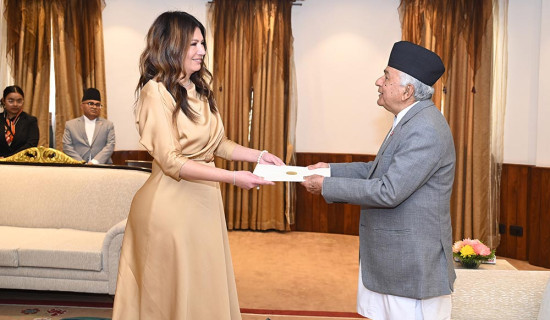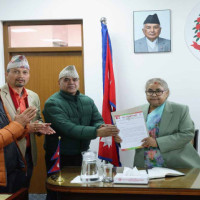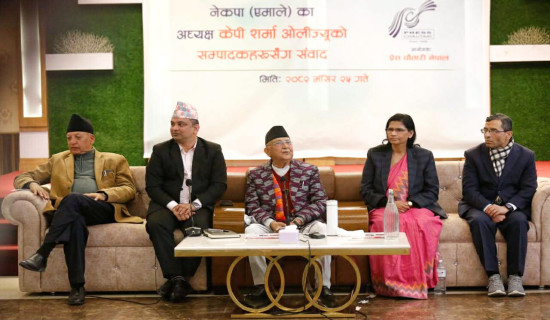- Thursday, 11 December 2025
Taudaha sees a tumble in winter water fowls
Kathmandu, Jan. 22: The water bird census in Kathmandu has revealed a concerning trend this year, with a noticeable decline in the number of birds found in and around Taudaha, Bagmati, and Manohara.
Dr. Hem Sagar Baral, a prominent ornithologist, has issued a warning that Taudaha, the renowned pond where birds from as far as Siberia in Africa used to migrate during winter, may be devoid of any birds within a few years.
"The situation in Taudaha is of serious concern, where the once thriving population of 400 to 500 individuals across different species has now dwindled to a mere 39 individuals. Continuing bird counts in the area seems futile, so we have decided not to conduct bird counting in the Taudaha area from next year," he added.
Dr. Baral informed that only three species of duck families – tufted duck, common teal, and gadwall – along with two other species of birds, including the great cormorant and black-crowned night heron, were recorded in the Taudaha area.
The situation in Bagmati and Manohara is also disheartening. Only 127 individuals were recorded in Bagmati, including the grey-headed lapwing and long-billed plover. Only one individual of the long-billed plover was recorded in Bagmati. In Manohara, only 333 individuals were observed, with 102 individuals of cattle egret recorded in the area.
"Birdwatchers were actively involved in the counting, working diligently from 8:30 am to 5:00 pm, covering a longer distance compared to previous years. However, the results did not yield the expected excitement," he said.
The decline in the winter bird population within the Kathmandu Valley is a consequence of the swift and unplanned urbanization, haphazard development, and encroachment upon rivers and wetlands.
The census results have not been received from across the country, and in some areas, the count is being repeated due to persistent cloud cover throughout the day. The enumeration was reiterated at Fewa Lake last Saturday, and a similar repetition is scheduled for Jagdishpur Lake very soon due to unsatisfactory results attributed to cloud cover.
The results from other areas are also less satisfactory compared to previous years. Unlike last year when the skies were clear, enabling timely counting, this year, persistent clouds in the Tarai region have hampered the counting process.
It will take a few weeks for the detailed report of the count to be compiled, Dr. Baral said. Various organisations in different districts are collaborating on the 37th water bird census, led by Himalayan Nature this year. This census focuses on counting water-dependent species, including ducks, eagles, and other birds.
As snow blankets the northern part of Russia, Mongolia, Kazakhstan, Kyrgyzstan, and China in the northern hemisphere, birds from these regions migrate to seek food and warmth, contributing to the increased winter bird population in Nepal. Mainly belonging to the duck family, the migratory species include black-headed ducks, long-tailed ducks, malak ducks, Khoya ducks, nadun ducks, and others.
Counting these birds is relatively straightforward as water birds often gather in water bodies after foraging in fields. During the counting process, binoculars are used to ensure accurate identification, avoiding double counting of the same bird.
The Bird Counting Campaign spans 15 river systems, including Koshi, Bagmati, Manohara, Karra, Rapti, Narayani, Khageri, Dhungre, Telar, Dano, Tinau, Bijaypur, Rara, Paschim Rapti, Karnali, and Mahakali.
According to Dr. Baral, in case of Kathmandu Valley, the escalating trend of urban expansion has led to habitat loss and disruption, adversely impacting the ecosystems that serve as crucial havens for migratory birds. Uncontrolled development, coupled with insufficient conservation measures, has further exacerbated the challenges faced by these avian species.
The encroachment upon rivers and wetlands, critical habitats for various bird species, has disrupted the natural balance and accessibility of resources, contributing significantly to the observed decline in the local bird population during the winter months, he said.
Addressing these issues necessitates a comprehensive approach, integrating urban planning, environmental conservation, and sustainable development practices to ensure the preservation and restoration of avian habitats in the Kathmandu Valley, Baral added.
















